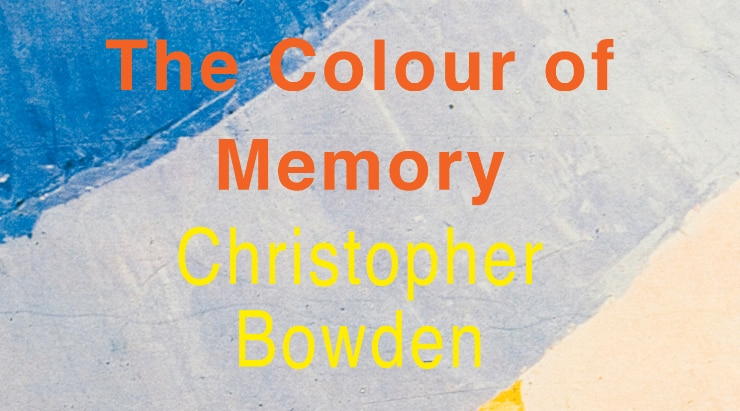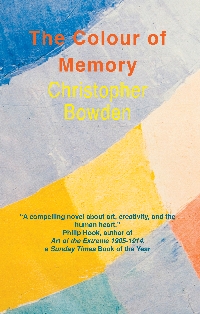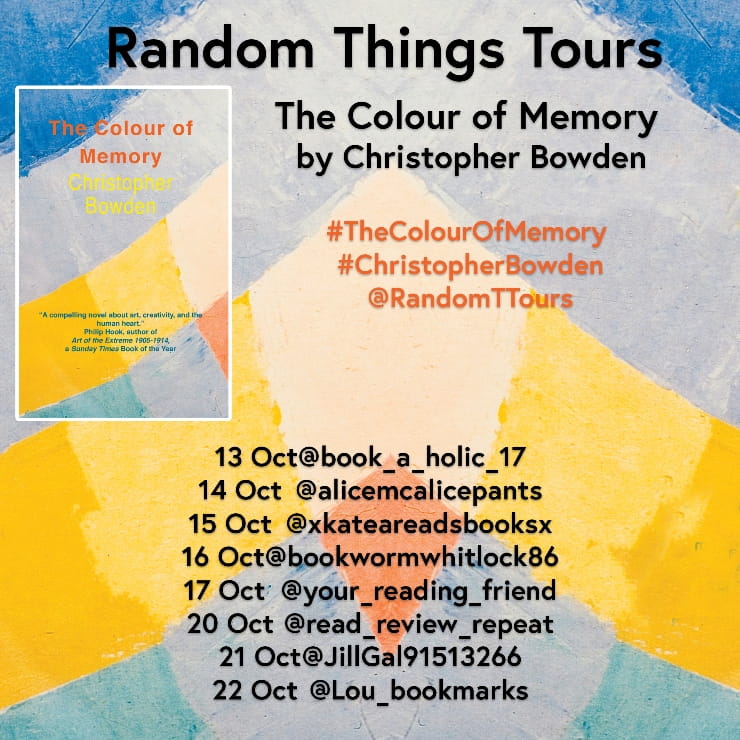Blog tour: The Colour of Memory by Christopher Bowden

This post is part of a blog tour organised by Random Things Blog Tours. I received a free copy of the book in return for an honest review.
‘Lucy Potter is a successful artist but she has done no new work in months. She fears she has lost the creative spark that sustained her and enabled her to express her view of the world. Will she ever regain it?
‘The chance discovery of an old notebook while on a walk in the woods provides a welcome distraction, raising questions she cannot answer. Who wrote it, why is it in code, what secrets does it hide? And why does it include the address of a house that does not exist?
‘Partial decoding of the notebook, surely written many years ago, reveals troubling incidents in the life of an unnamed girl. Deeply affected by the girl’s plight, Lucy feels impelled to find out who she is or was and what happened to her. Could she still be alive?
‘Lucy’s search for answers has an outcome she could never have anticipated. But will the re-appearance in Lucy’s life of fellow artist Rex Monday help or hinder her attempts to re-establish her position in the art world – and provide the stability she needs in her personal life?’

In The Colour of Memory, by Christopher Bowden, we meet Lucy Potter – an established, middle-aged artist who’s felt creatively blocked for some months, and is worried she’ll never repeat, let alone exceed the success of her previous work.
One day, while taking a constitutional in her south London neighbourhood, Lucy discovers a mysterious notebook written in code, sending her in an unexpected direction as, with some help from her friends, she starts to unravel its mysteries and tracks down its owner, who has a surprising proposition for her.
Along the way, she finds inspiration for some promising new compositions and starts a new relationship with fellow artist Rex Monday, who attended art school with her three decades previously. Could it all be coming back together for Lucy?
On the whole, I’d describe The Colour of Memory as a light, comforting read. Everything was very richly-described, reflecting Lucy’s own perceptions of the world around her as well as bringing all the scenes to vivid life.
I really enjoyed all the insights into the life of a successful artist, whether that was learning that Lucy being blocked didn’t mean she wasn’t creating anything at all (she still practises drawing still lifes for an hour every morning); seeing how she found inspiration in the most commonplace of objects; or living through her vicariously as she did her best work, managed the more businesslike side of her job, and talked about art with other artists.
The stakes don’t feel nail-bitingly high at any point – Lucy is no struggling artist, having already exhibited in New York(!) and presumably receiving some level of income from licensing of her existing work. We come to her biggest challenge – her artist’s block – in its later stages, not long before she starts creating in earnest again. It did seem like she could succeed at any form or style of art she turned her hand to, even if she didn’t think so herself!
It was also clear from the outset that the events described in the deciphered opening pages of the notebook were written from the perspective of an adult who had obviously long since survived them, so there was no major sense of urgency about tracking down its owner.
That’s not to say that the memories in the notebook, or the other details its writer eventually shares with Lucy face-to-face, aren’t shocking or heart-rending, though. It’s clear that its author was traumatised by the experiences she had as a child and, as Lucy comes to learn, her suffering didn’t end there. I especially appreciated how the story ended with a couple of questions about the writer left unanswered.
There were a few messages that particularly stayed with me after finishing this book. One is the idea that art is, first and foremost, an expression and offering-up of the world from your unique point of view (and that’s why AI art is an abomination!).
Another is how someone telling you at a young age that you’re not good at something can create a lasting negative belief about yourself and hold you back – ever since getting harsh feedback on a portrait she created in college, Lucy has insisted she ‘doesn’t do people’.
We’re also reminded that life is a marathon, rather than a sprint. When you have a success, you feel great for a while, but time goes on, the feeling of triumph fades, you have to continue working hard to maintain that standard (you’re only as good as your last book/album/film/etc.), and you worry that your best work is already behind you (heck, I feel like this most of the time, and all I’ve done is write a handful of short stories!). So I did feel empathy for Lucy in that respect, even if I didn’t feel her despair to the extent I might have done if I’d met her further back from her creative resurgence.
The Colour of Memory is a light, interesting, and engaging read.
